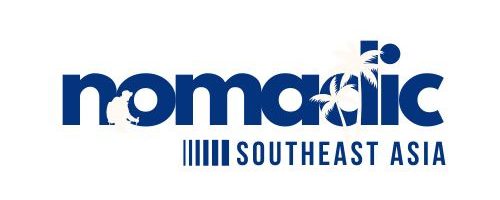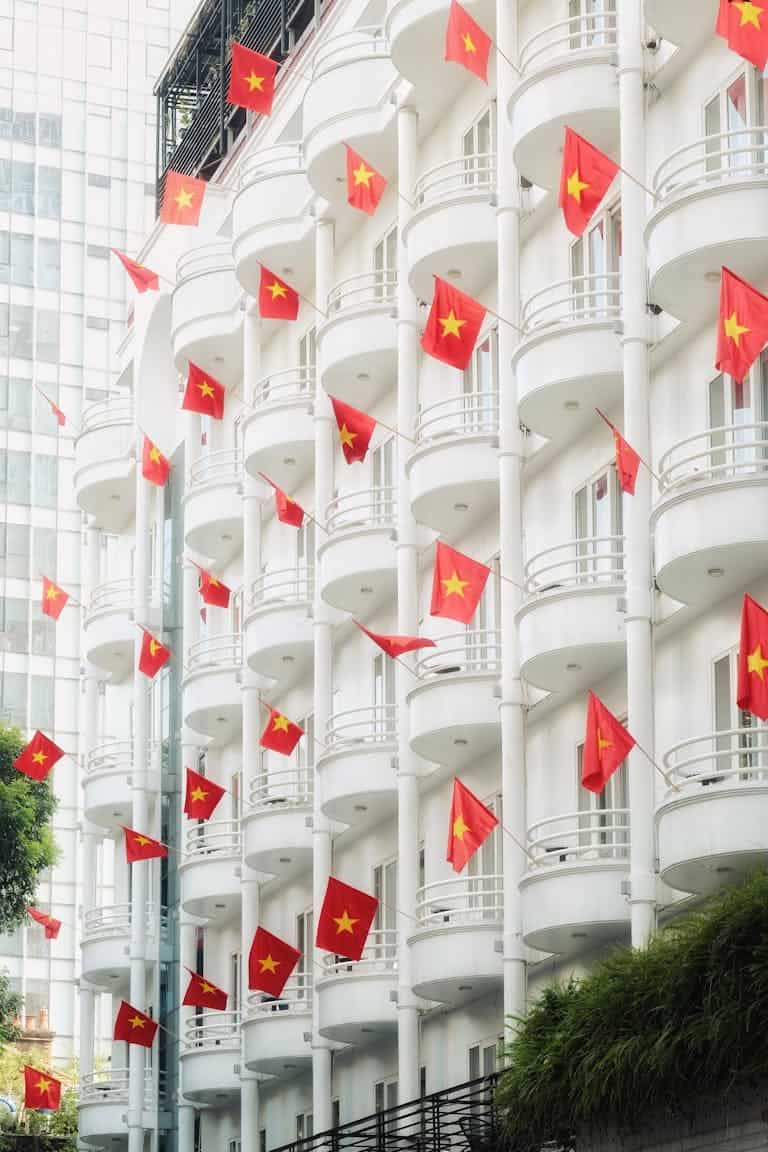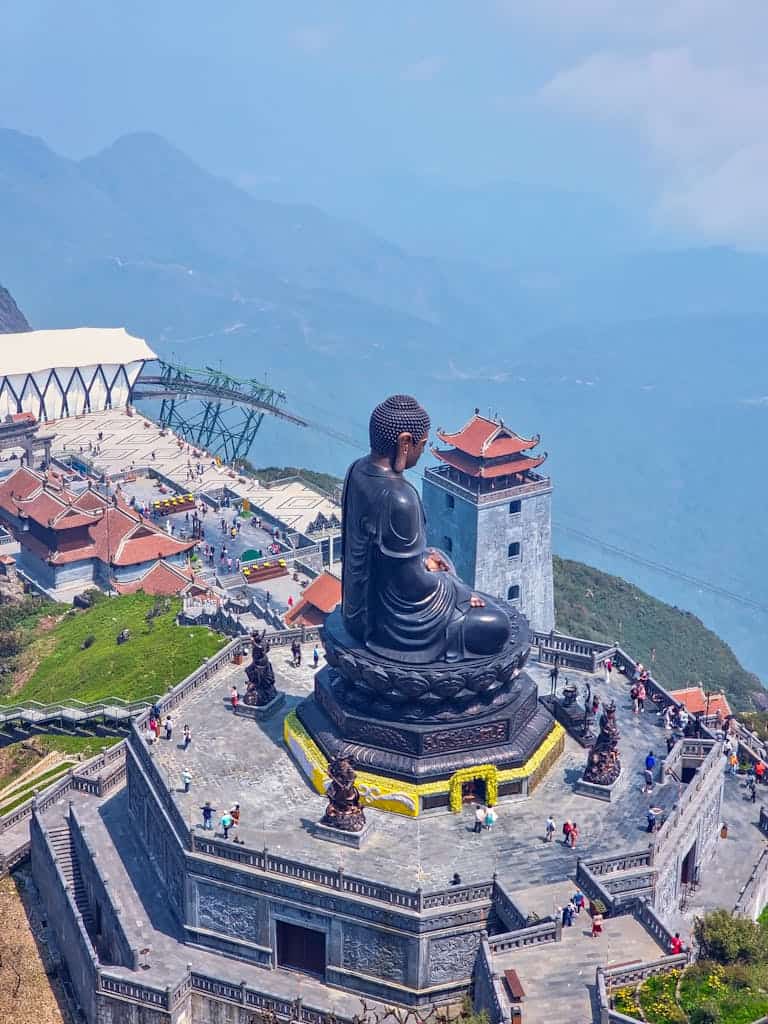Backpacking Vietnam: Ultimate 2025 Adventure
Nomadic Southeast Asia contains affiliate links and is a member of the Amazon Services LLC Associates Program. If you make a purchase using one of these Amazon links, I may receive compensation at no extra cost to you. See my Disclosure Policy for more information.
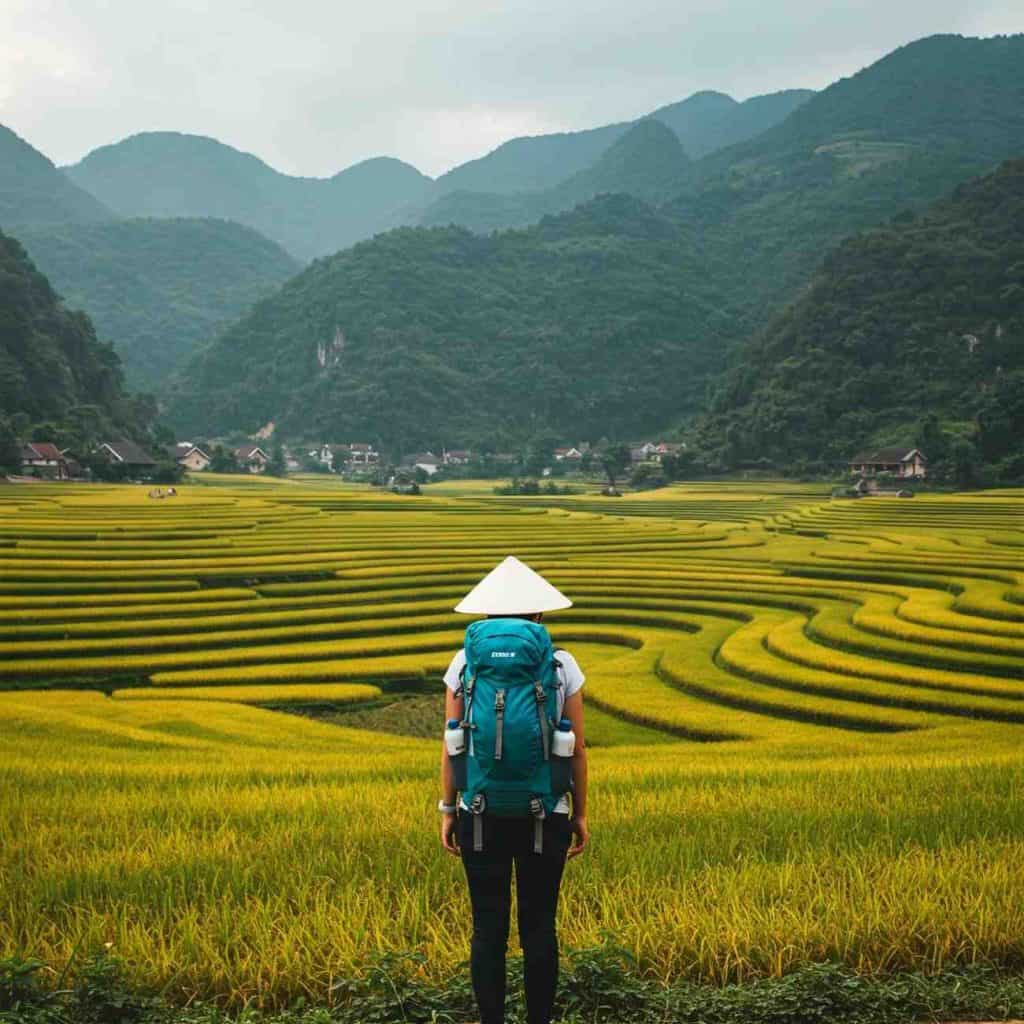
Have You Ever Dreamed of Your First Step in Vietnam?
Just image the second you walk out of Noi Bai Airport, Hanoi’s thick fragrant air hits you—a mix of motorbike exhausts, street foods, and something earthy you can’t explain.
Your backpack straps dig into your shoulders, but you’re excited and don’t notice. After months of imagining this moment, you are finally here.
Vietnam doesn’t just welcome you—it overwhelms you in the best way.
The jagged peaks of Ha Long Bay rising from emerald water. The deafening hum of Saigon’s traffic, a ballet of bikes weaving past street vendors.
That first sip of cà phê sữa đá—”strong and sweet” Vietnam coffee, which is impossible to replicate back home.
But here’s what no one tells you: Vietnam rewards those who go beyond the obvious.
After your first backpacking Southeast Asian trip, you’ll learn what no guidebook can warn you about: visa rule surprises, monsoon-season detours, and the art of haggling without offending.
If you’re ready to trade packaged tours for real adventures—the kind where you end up drinking rice wine with locals or chasing sunrise over terraced rice fields.
I’ve got the unfiltered, up-to-date insights you need.
Let’s explore Vietnam the way it should be: raw, unpredictable, and utterly unforgettable.
P.S. That bánh mì you’ve heard about? It’s even better when you buy it from a sidewalk vendor for 50 cents.
Key Takeaways
- Prepare your backpacking trip by researching routes, visa info, and local weather patterns to enjoy a smoother experience.
- Stay on budget by balancing where you eat and sleep, using tools like Travelstart to score good deals on transport.
- Keep your belongings secure and trust your gut about safety; local tips can be golden!
- Explore different regions of Vietnam to find unique cultural experiences, whether itâs in bustling cities or quieter towns with rich stories.
Nomadic Southeast Asia is here to guide you in monetizing your travel passion. Our blog shares practical advice on living abroad, travel insights, and how to start your own blogging business step-by-step!
Backpacking Vietnam: Planning and Preparation
Choosing Your Vietnam Backpacking Route
When backpacking through Vietnam, planning your route is the first step. You may want to focus on both popular tourist trails and hidden gems.
A few pointers:
- Begin by outlining the regions you want to visit. Northern Vietnam offers hills, stunning landscapes and cooler air, while the South is known for its lively cities and tropic warmth.
- Consider travel time between major cities and remote areas. Use online route-planning tools to gauge if long bus rides or occasional flights will suit your schedule.
- Mix well-known routes with off-the-beaten-path stops. Many backpackers enjoy a route that starts in Hanoi, winds through lesser-known valleys and ends in Ho Chi Minh City.
Vietnam Visa Requirements: Who Needs One?
Visa Exemptions
- Vietnam has visa exemption agreements with several countries.
- The duration of these exemptions varies (typically 15 to 90 days).
- Common countries with short-term visa exemptions for tourism include many Southeast Asian nations, some European countries (like the UK, France, Germany, Italy, and Spain, though these often have specific conditions and durations), and a few others.
Always check the official Vietnam Tourism website or the Vietnamese embassy/consulate in your country to see if your nationality qualifies for visa-free entry and for how long.
Visa on Arrival (VOA)
- For citizens of many other countries, a Visa on Arrival is a common option, especially for tourist purposes.
- However, VOA typically requires pre-approval.
E-Visa (Electronic Visa):
- Vietnam has implemented an e-visa system for citizens of a wider range of countries.
- This allows you to apply for your visa online, receive an electronic grant letter, and then present this upon arrival to receive your visa stamp.
- This is often a more convenient option than traditional VOA.
Embassy/Consulate Visa
- You can also apply for a visa directly through the Vietnamese embassy or consulate in your country of residence.
- This might be necessary for certain visa types (e.g., business visas, longer-stay visas) or if you prefer this method.
Types of Tourist Visas
- Validity Period
- Tourist visas typically have a validity period ranging from one to three months.
- Ensure your planned travel dates fall within this period.
- Single Entry:
- This visa allows you to enter Vietnam only once within its validity period.
- If you leave and want to re-enter, you’ll need a new visa.
- Multiple Entry:
- This visa allows you to enter and exit Vietnam multiple times within its validity period.
- This is useful if you plan to visit neighboring countries and then return to Vietnam.
For many countries citizens, a visa is required prior to arrival or available on arrival. To ensure smooth border crossing:
- Check the official Vietnam Tourism website for the most recent visa policies.
- Many travelers opt for a tourist visa that can be extended if needed. The process might involve a visa approval letter booked through a trusted agency and then getting a stamp upon arrival.
- Plan ahead if you intend to travel near borders or if your passport requires validity for at least six months from your planned entry date.
Note: Key Issues Checklist for Vietnam Backpackers
- Land Border Crossings
- If coming in or exiting Vietnam by crossing over land borders (e.g., from Cambodia, Laos, or China), the visa procedures and requirements could be different than air arrival.
- Note specifically what land border you are crossing through and get the relevant visa prior since VOA can be denied at land borders.
- Passport Validity
- As mentioned, your passport must have a minimum of six months’ validity remaining from the date you plan to enter Vietnam.
- Immigration officials strictly follow this requirement, and you might be rejected if your passport is nearing expiration.
- Blank Passport Pages
- Ensure that you have enough blank pages within your passport for entry and exit stamps.
- At least two blank pages is generally suggested.
- Maintain Copies
- Produce electronic and paper copies of your passport, visa approval letter (if needed), and visa.
- Keep them independently from your actual documents.
- Get Informed
- Visa requirements are subject to last-minute change.
- Always visit the official Vietnam Tourism website (which is most commonly linked with the Ministry of Foreign Affairs or the Immigration Department) or your native country’s Vietnamese embassy/consulate for current information before going there.
- Travel Insurance
- While not technically visa-related, ensure that you have appropriate travel insurance which encompasses medical coverage as well as other unforeseen incidents.
Weather Considerations
Vietnam’s weather can be unpredictable. Weather patterns vary significantly:
- In the north, expect cooler winters and foggy mornings around Hanoi and Sapa, while summer can become extremely humid.
- The central region might face typhoons between August and November.
- The south is notably warm all year, with a rainy season typically from May through November.
- Pack items for varied climates including layers for cooler nights in the mountains and breathable clothing for steamy southern cities.
🚌 Getting Around Vietnam: Your Best Transport Options
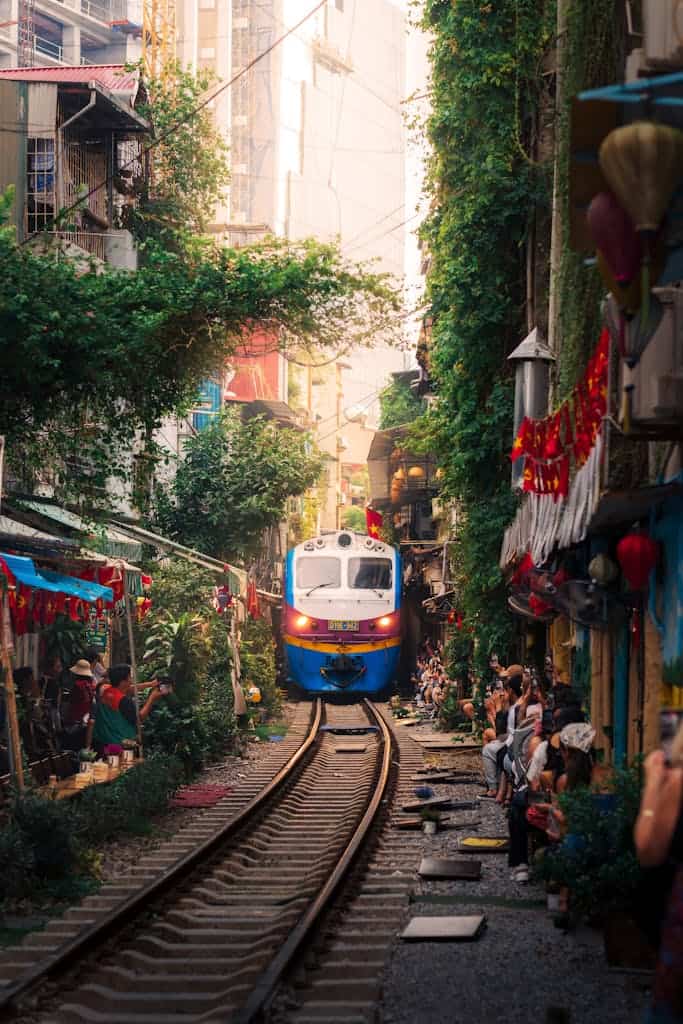
Vietnam’s transportation network is diverse—whether you want budget-friendly buses, scenic train rides, or the freedom of a motorbike. Here’s the real deal on how to navigate like a pro:
| Option | Cost 💰 | Comfort 🛋️ | Speed ⏳ | Flexibility 🔄 | Best For 🌟 |
|---|---|---|---|---|---|
| Bus | Low | Basic (can be cramped) | Moderate | High (frequent routes) | Budget travelers, short hops |
| Train | Moderate | Comfortable (sleepers available) | Slow-moderate | Moderate (fixed schedules) | Scenic journeys (e.g., Hanoi to Da Nang) |
| Motorbike Rental 🏍️ | Low-moderate | Depends on your riding skills & gear! | Fast in cities, slow in countryside | Ultra-high (go anywhere) | Adventurers, off-the-beaten-path explorers |
| Domestic Flights ✈️ | Moderate-high | Very comfortable | Blazing fast (1-2 hrs vs. 12+ by train) | Low (flight schedules) | Saving time (e.g., Hanoi → Ho Chi Minh City) |
Quick Tips:
- Buses are cheap but can be crowded—opt for limousine buses (like The Sinh Tourist) for extra comfort.
- Trains offer stunning coastal views—book a soft sleeper for overnight trips.
- Motorbikes = ultimate freedom, but always wear a helmet and check rental insurance.
- Flights are worth it for long distances (VietJet & Bamboo Airways often have deals).
💰 Vietnam on a Budget: How to Stretch Your Dong (Without Getting Scammed)
Let’s be real—Vietnam is cheap, but only if you know the tricks. Backpackers can blow 450/day, while others live like kings on $20/day.
The difference? Street-smart hacks and safety secrets only seasoned travelers know.
Here’s your no-BS guide to traveling Vietnam safely and affordably—from dodging pickpockets to scoring the best $1 street food.
🍜 Budget Breakdown: How Far Will Your Money Go?
| Expense | Budget ( $15-20/day) | Comfort ( $25-35/day) | Splurge ($50+) |
|---|---|---|---|
| Hostel | $5 dorm bed | $10 private hostel room | Boutique hotel |
| Food | 1banhmi+1banhmi+2 pho | $5-7 sit-down meals | Fancy restaurants |
| Transport | Local buses ($1-3) | Grab bike ($2-5 rides) | Private taxis |
| Activities | Free temples & hikes | $5-10 museum entries | Ha Long Bay cruises |
Pro Tip: Withdraw large ATM sums to avoid fees (Vietcombank has lowest charges). Always decline “dynamic currency conversion”!
🚨 Safety Essentials: Don’t Learn This the Hard Way
✅ Theft-Proofing:
- Use a crossbody bag with slash-proof straps in markets.
- Scam Alert: Taxis with “fake meters” (stick to Grab/Mai Linh).
✅ Health Hacks:
- Avoid ice in rural areas (except at busy spots where it’s commercial).
- Pharmacies sell antibiotics without prescriptions—bring a cheat-sheet of med names.
✅ Digital Safety:
- Buy a Viettel SIM at the airport (cheaper than international plans).
- VPNs are a must—ExpressVPN works best for Netflix/Google.
📶 Staying Connected: WiFi Wars & SIM Card Secrets
- Best SIM: Viettel SIM (best coverage in mountains/remote areas).
- Pro Hack: Ask your hostel for a SIM—they’ll often register it for you (avoiding paperwork).
- Power Bank Rule: Carry a 20,000mAh charger—outlets vanish on sleeper buses!
💡 Insider Tricks to Save Like a Local
🍽️ Eat Where Motorbikes Park: A crowd of locals = fresh, safe, cheap food.
🚍 Overnight Buses = Hostel + Transport: Save $10 by booking limousine buses (FUTA, The Sinh Tourist).
💧 Water Refills: Many hostels/cafés offer free filtered water—bring a reusable bot
“But is Vietnam really safe?”
Like anywhere int he world, the answer is Yes—if you avoid flashing cash at 2am in Bui Vien and learn to say “KHÔNG” firmly to pushy vendors.
Essential Backpacking Gear and Packing Strategies
Backpacking Gear List
When choosing your gear, functionality and durability go hand in hand with weight considerations:
- A sturdy backpack around 40-60 liters is ideal for long trips.
- A waterproof cover for your backpack protects your belongings during unexpected downpours.
- Comfortable clothing suitable for humid and hot climates, together with a few lightweight warm layers if you plan mountains visits.
- A pair of good walking shoes, sandals, and flip-flops for flexibility.
- Personal care items such as a compact first-aid kit, portable water filter, and basic toiletries.
- A durable phone with offline maps, extra chargers, and a universal power adapter.
- Quick-drying towels and multipurpose tools can come in handy.
Packing Strategies
Packing efficiently can make all the difference:
- Roll your clothes instead of folding to save space.
- Use packing cubes or zip-lock bags to organize items in your backpack. This makes it easier to access items quickly.
- Keep heavy items close to your back for better stability when walking.
- Prepare a small daypack for short excursions and keep valuables in an easily accessible pouch.
- Leave a little extra room for souvenirs and items you might pick up along the way.
- Consider the weather: pack layers for unexpected changes and make sure your clothes dry quickly if caught in rain.
Local Food and Cultural Experiences
One of the best parts of backpacking in Vietnam is enjoying a dynamic food scene and deep cultural experiences:
- Explore street food like pho, banh mi, and fresh spring rolls. Vendors often provide an authentic taste of local culinary traditions.
- Visit local markets and small eateries. They are great for interacting with locals and learning about regional specialties.
- Try taking a cooking class in cities like Hoi An or Hue, where you learn the secrets behind Vietnamâs famous dishes.
- Participate in local festivals or community events. Many small towns hold celebrations that let you experience traditional dances, music, and crafts.
- Keep your mind open to meeting residents and learning their personal stories. These encounters often lead to extra tips on hidden spots or must-try local treats.
Vietnam: Must-Visit Destinations and Off-the-Beaten-Path Spots
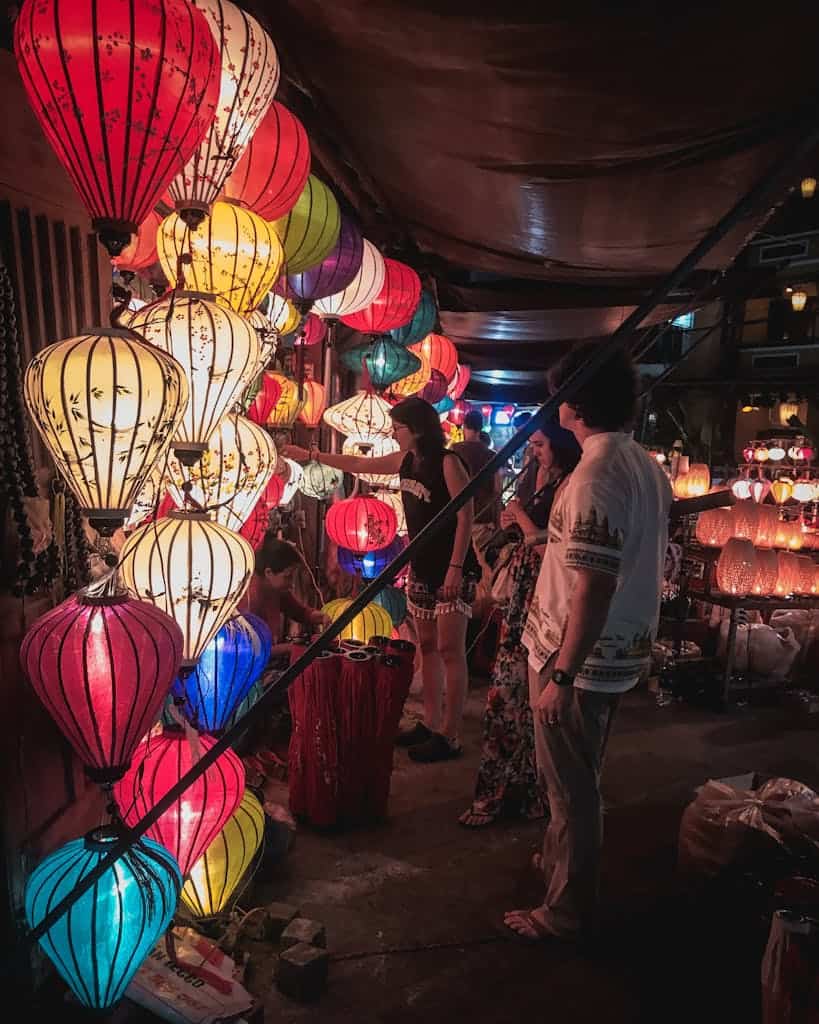
Popular Destinations with a Twist
Vietnam brims with well-known attractions, yet some unexpected spots offer just as much charm:
- Hanoi remains the beating heart of northern culture. Wander the Old Quarter, try its many street food stalls and let the maze of streets surprise you.
- Ho Chi Minh City is more than a buzzing urban center. Look for local art galleries, rooftop bars along the Saigon River, or traditional music performances in hidden alleys.
- Hoi An is famous for its lantern-lit streets, but a short ride outside the city will get you to small villages where traditions remain more intact.
- In Da Nang, besides visiting popular beaches, consider riding a motorbike to explore the nearby Marble Mountains.
Off-the-Beaten-Path Spots
For backpackers looking for unique experiences, certain areas are less frequented by tourists:
- Explore the Ha Giang province in the north. Its terraced fields, ethnic minority villages and dramatic mountain passes offer raw, untouched beauty.
- The Central Highlands, including Buon Ma Thuot, feature coffee plantations and tribal cultures that many travelers overlook.
- Along the coast, lesser-known beaches in Binh Thuan can be a peaceful escape from crowded tourist routes.
- Check out remote areas around Phong Nha-Ke Bang National Park. The caves here are impressive, and the local villages provide insights into Vietnamese rural life.
Historical Insights and Community Recommendations
Vietnam’s history is rich and layered, and many destinations offer glimpses into the nation’s past:
- Visit ancient citadels and remnants of dynastic rule. Historical towns like Hue reveal architecture that speaks to centuries-old traditions.
- Historical museums in Hanoi and Ho Chi Minh City deliver context about the country’s multifaceted past, from colonial influences to war histories.
- Engage with local communities through homestays or guided village tours. This offers an immersive experience that no standard tour package can guarantee.
- Many online backpacking communities share updated itineraries and tips. Forums and social networks give recommendations on practical matters like hidden eateries, safety tips and suggested routes.
Consider using checklists for planning:
- List your absolute must-see historical sites.
- Write down community suggestions and compare them with published travel guides.
- Use local insights to adjust your itinerary on the go for a more authentic experience.
- Making notes in a travel journal not only records memories but helps with future planning if you decide to revisit similar regions.
Internal resources can sometimes offer more localized advice. For instance, our post on Local Travel Secrets provides firsthand insights shared by experienced backpackers.
Further Resources and Useful Links For Vietnam Packing
For more detailed information and independent guides, the following resources offer in-depth insights:
- Rough Guides dives deep into cultural insights and real-life experiences, serving as a valuable tool if youâre looking to explore beyond the typical tourist circuits.
- Vietnam Tourism is the official site for travel info. It’s a good starting point for checking visa rules, local events and province-specific travel advice.
- Travelstart makes it easier to book flights and accommodations with competitive prices and a user-friendly platform.
Additional Tips for a Smooth Experience
- When planning, a flexible mindset works best. Sometimes, the best stories come from unplanned adventures.
- Keep your travel documents safe and accessible. Digital scans saved on your phone or a cloud storage account can be invaluable.
- Don’t hesitate to ask fellow travelers or locals for recommendations. The backpacker community in Vietnam is warm, friendly and willing to share insights.
- Balance your schedule with planned activities and free time. Over-planning can lead to burnout, while spontaneity may lead to unexpected delights.
- Use travel apps for navigating streets, finding local food joints or securing last-minute hostel deals. These small tools often make a big difference.
- Remember that discomfort or uncertainty is part of the journey. Each challenge is an opportunity to learn something new about yourself and the world around you.
Vietnam Travel Essentials: Quick-Reference Guide
A concise summary of key trip-planning factors for Vietnam:
| Category | Key Points | Tips |
|---|---|---|
| Route & Visa | Diverse landscapes (mountains, coast, cities). Visa requirements vary by nationality. | Apply for e-visas early (govt. site only). Check entry/exit points. |
| Weather | North: Cool winters, hot summers. South: Tropical (wet/dry seasons). Central: Typhoon risk (Sep–Nov). | Pack layers + rain gear. Monitor forecasts regionally. |
| Transportation | Buses (cheap), trains (scenic), motorbikes (rental risks), flights (time-savers). | Use 12Go Asia to compare options. Ride-hailing apps (Grab) for cities. |
| Budget | 20–30/day(budget),20–30/day(budget),50+/day (comfort). Costs rise in tourist hubs (Hanoi, HCMC). | Carry small VND bills. Avoid street ATMs (skimming risk). |
| Gear & Packing | Lightweight, quick-dry clothing. Anti-theft bag for cities. Sturdy shoes for hikes. | Roll clothes + waterproof packing cubes. Include meds + photocopies. |
| Cultural Experiences | Street food (try phở, bánh mì), homestays (Sapa, Mekong), festivals (Tet). | Learn basic Vietnamese phrases. Respect temple dress codes. |
| Historical Insights | War museums (HCMC, Hanoi), ancient towns (Hội An), Cu Chi Tunnels. | Research context beforehand. Support ethical tourism initiatives. |
Pro Tips:
- Reconfirm visa rules (e.g., 15-day visa-free for some EU nationals).
- Health: Drink bottled water; consider hepatitis A/tetanus vaccines.
- Connectivity: Buy a local SIM (Viettel/Mobifone) at airports.
Adjust plans for peak seasons (Dec–Mar, July–Aug) and leverage traveler forums (e.g., Lonely Planet’s Thorn Tree) for real-time updates.
Exploring Vietnam as a backpacker is about mixing careful planning with a spirit of adventure.
Use these steps as a foundation to build your personalized itineraries.
Let every new experience, whether its a spontaneous motorbike ride through winding mountain roads, sampling incredible street food, or engaging in heartfelt conversations with locals guide your journey.
Backpacking across Vietnam promises a blend of structured planning and wild, unscripted moments of discovery.
Embrace every twist the road takes, and remember that even if your plan changes, youâre still adding chapters to a memorable adventure.
Bonus: Quick How-To for Local Connectivity Setup
- Purchase a local SIM card upon arrival at the airport or at a local vendor.
- Check providers like Viettel or Vinaphone, which are popular and reliable.
- Register your SIM by showing your passport, as per regulations.
- Once activated, verify that your data plan suits your travel needs, whether for maps, chat apps or emergency use.
Following these simple steps ensures you remain updated on any last-minute travel tips shared by the online backpacking community or locals you meet along the trail.
Remember, while details in guides offer a great starting point, allowing yourself room for spontaneity often makes for the most rewarding experiences.
Enjoy planning your journey as much as the adventure itself.
Final Thoughts
In this guide, we put together all the essentials for an adventurous backpacking journey in Vietnam. From smart planning and budgeting to genuine local experience.
We shared visa info, the best routes, must-have gear, and useful travel advice to simplify your travels and maximize your adventure.
But learning is not done here. For serious analysis, expert guidance, and how to make your travels valuable (and even profitable) experiences, join us at Nomadic Southeast Asia.
Whether backpacking in Vietnam or exploring the wider region, we’re here to help you learn more and earn along the way.
Your Southeast Asian adventure starts now—let’s make it unforgettable. 🌏 ✈️
Frequently Asked Questions (FAQs)
How do I plan my Vietnamese backpacking trip?
Start by mapping out the key routes you want to explore, checking visa needs, and aligning your travel dates with the weather. Use resources like [Vietnam Tourism](https://vietnam.travel/) to get updated info, then set a budget and figure out your must-visit spots. Itâs a mix of online research and talking to fellow travelers.
What are the visa requirements for backpacking in Vietnam?
Visa rules for Vietnam can change often, so its best to check ahead of time. Usually, you can apply online through the official channels or visit your local embassy’s website. Keep all your travel docs and be prepared for a bit of paperwork as this helps to avoid any hiccups when arriving at your destination.
When is the best time to visit Vietnam?
The best time really depends on where you plan to go in Vietnam. Northern regions tend to be cooler from November to April, while southern spots are warm year-round. So, plan based on the experiences you wantâwhether it’s cooler mountain air or tropical beach days. Some flexibility in your dates often works best!
How can I stay safe and budget wisely while backpacking in Vietnam?
Always keep a close eye on your belongings, use trusted transportation options like [Travelstart](https://www.travelstart.com/) for booking, and keep emergency funds handy. Avoid overly expensive tourist traps by asking locals for adviceâplus, using apps like [Lonely Planet](https://www.lonelyplanet.com/) can help you find both safe and affordable options.
How can I monetize my passion for travel with our expertise focused on Southeast Asia?
Nomadic Southeast Asia is all about sharing travel insights and step-by-step guides to build your own blogging business. Explore our resources on Nomadic Southeast Asia for tips on turning your travel adventures into a sustainable income. This includes advice on content creation, digital marketing strategies, and networking with other bloggers across Southeast Asia.
